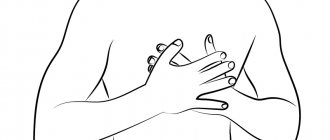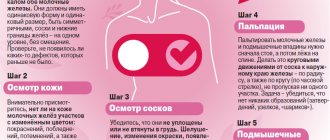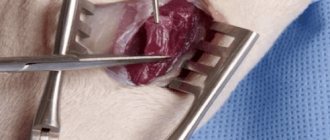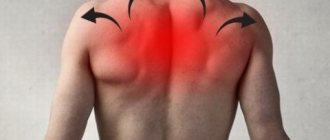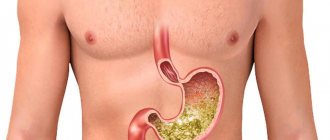Chest pain
(chest pain) is a common symptom. In many cases, chest pain can be caused by heart disease, and this makes it especially serious. However, the list of causes of chest pain is much wider. This area contains the heart, lungs, esophagus, large vessels, bones and muscles - and any of these organs can be a source of pain. Chest pain can also be caused by the diaphragm and abdominal organs, primarily the stomach. Finally, pain can be caused by problems in other organs, and its localization in the chest is explained by the complex arrangement of nerves and muscles.
Possible nature of chest pain - what you should pay attention to
Chest pain can be aching, stabbing, shooting, squeezing, burning. In some cases it can be acute, intense, even intolerable.
It is important where exactly the pain is localized. Usually the pain can be quite clearly localized as follows:
- in one half of the chest - right or left. Sometimes the localization of pain can be more specific, for example, in the ribs;
- behind the sternum. Pain behind the sternum, especially when it hurts both behind the sternum and to the left of it, is characteristic of heart disease;
- just below the sternum (in the epigastric region). Such pain is typical for diseases of the digestive tract (stomach or esophagus).
Chest pain without a clear localization may indicate lung cancer or tuberculosis.
Chest pain may be accompanied by symptoms such as:
- shortness of breath, difficulty breathing;
- cough, increased body temperature;
- weakness, cold sweat;
- belching, heartburn, nausea, vomiting;
- changes in blood pressure.
The distribution of pain is also important for diagnosis. The pain may radiate to the arm. This type of pain is observed with myocardial infarction and osteochondrosis.
What can hurt your chest?
Diagnostics
The first thing the doctor will do is interview and examine the patient, which will allow him to narrow the search for pathology based on associated symptoms. After this, various diagnostic procedures may be prescribed to determine the cause of the pain. Magnetic resonance imaging may be helpful
or
computed tomography
,
x-ray
, ultrasound, blood tests, etc. This will determine why pain occurs in the middle of the chest, which radiates to the back, upper limbs or ribs.
Causes
Chest pain due to heart disease
Chest pain is a characteristic symptom of heart disease. It is observed, in particular, when:
- coronary heart disease (caused by insufficient oxygen supply to the heart muscle). The most common form of coronary artery disease is angina pectoris, which manifests itself in the form of discomfort, a feeling of heaviness or compressive pain behind the sternum and to the left of it. An attack of pain is usually provoked by physical activity or emotional stress. The duration of the attack usually ranges from several minutes to half an hour. Relief occurs after taking nitroglycerin. The pain may be accompanied by shortness of breath, radiating to the left arm, under the shoulder blade, and the left half of the lower jaw;
- acute myocardial infarction. Myocardial infarction is also a form of coronary heart disease that requires immediate medical attention. The pain during myocardial infarction is very intense and has a compressive, pressing or bursting character. It is observed behind the sternum and to the left of it, and can radiate to the left arm, under the shoulder blade, to the left side of the neck and lower jaw. The pain is accompanied by shortness of breath, fear of death, weakness, and cold sweat may appear. The pain lasts more than 15-30 minutes (i.e. longer than during an attack of angina) and is not relieved by nitroglycerin. If you suspect a myocardial infarction, you should immediately call an ambulance;
- pericarditis (inflammation of the outer lining of the heart - the pericardium). In this case, the pain may be constant or intermittent. It is usually localized behind the sternum. The pain increases when lying down, and decreases if you lean forward;
- myocarditis (inflammation of the heart muscle). Myocarditis occurs most often as a complication of an infectious disease. With myocarditis, chest pain is combined with fever and shortness of breath;
- mitral valve prolapse. In most cases, this disease is asymptomatic, but sometimes there is pain in the left side of the chest, which may be accompanied by a feeling of shortness of breath, a feeling of rapid or slow heartbeat, dizziness and fainting.
Chest pain due to respiratory diseases
Chest pain can occur with diseases such as:
- pleurisy (inflammation of the membrane of the lung - pleura). In case of pleurisy, the pain is usually acute and one-sided. Intensifies with deep breaths, laughter, and movement. The pain intensifies when bending to the healthy side. The pain decreases if you lie on the side where it hurts. Chest pain is combined with other symptoms - fever, chills, weakness, cough;
- pneumonia (pneumonia). Chest pain with pneumonia is a concomitant symptom that occurs against a background of cough and fever. The pain is usually one-sided - corresponds to the side on which inflammation develops. The nature of the pain is sharp or aching;
- bronchitis;
- tracheitis;
- pulmonary tuberculosis;
- lungs' cancer.
Chest pain due to diseases of the digestive tract
Pain in the chest area can be caused by diseases such as:
- stomach ulcer. With a stomach ulcer, the pain is usually described as “burning.” It is localized in the epigastric region and can radiate to the left half of the chest. Occurs after eating;
- gastroesophageal reflux disease (reflux of stomach contents back into the esophagus). Acidic or alkaline contents irritate the lining of the esophagus, causing bloating and severe pain in the epigastric region and the left side of the chest. An attack can be triggered by eating too much at night, strong coffee, or alcohol abuse. In addition to chest pain, heartburn and belching may occur;
- hiatal hernia. In most cases, the disease is asymptomatic. In some cases, aching or burning pain behind the sternum and in the epigastric region may be observed. Pain usually occurs after eating in a horizontal position. May be accompanied by hiccups, heartburn, belching, and sometimes vomiting (in obese women).
Other Possible Causes of Chest Pain
Chest pain can also be caused by:
- osteochondrosis of the cervical and thoracic spine. Pain with osteochondrosis can be similar to an angina attack and can radiate to the shoulder blade, arm, or shoulder. Sometimes there is numbness in the hand. Another option for pain with osteochondrosis is lumbago. It is provoked by turns of the body, movement of the arms, prolonged exposure to a lying position (during night sleep);
- intercostal neuralgia. In this case, the pain is usually limited to one intercostal space. The nature of the pain is “shooting”;
- shingles. The disease is caused by one of the varieties of the herpes virus. The pain is intense, burning. After 7-10 days, blistering rashes appear along the affected nerves;
- vegetative-vascular dystonia.
Treatment
Intercostal neuralgia requires complex and often long-term treatment, including medication, physiotherapy, massage, etc.
Drug therapy
In the acute phase of the disease, therapy is aimed at relieving pain and improving the patient's condition. Depending on the specific clinical situation, the following are prescribed:
- non-steroidal anti-inflammatory drugs (NSAIDs): products based on diclofenac, nimesulide, ibuprofen, meloxicam and their derivatives; used in tablet, injection and local (creams, ointments, patches) form;
- analgesics: analgin and products based on it; like NSAIDs, they relieve pain;
- muscle relaxants to eliminate muscle spasms: mydocalm, etc.;
- group vitamins: milgamma, neuromultivitis, etc.; necessary to restore normal functioning of nerve fibers;
- sedatives to reduce the psycho-emotional component of pain and improve sleep.
If necessary, the following may additionally be prescribed:
- anticonvulsants: inhibit the passage of pain impulses;
- antidepressants to relieve tension;
- antihistamines and diuretics: relieve tissue swelling, especially relevant for pinched nerve roots;
- antiviral drugs for herpes zoster;
- glucocorticosteroids for persistent pain and severe inflammation that cannot be relieved by milder means.
Physiotherapy and exercise therapy
Physiotherapeutic procedures are prescribed after the acute pain subsides. Help speed up recovery:
- UHF;
- reflexology;
- magnetic therapy;
- electrophoresis;
- laser treatment;
- paraffin applications;
- mud therapy.
These procedures help improve blood circulation and metabolism in the affected area and accelerate the regeneration of nerve tissue.
Physical therapy exercises are prescribed after complete recovery. The main goal of gymnastics is to unload the back muscles. The complex is developed individually. The first classes should be carried out under the supervision of a specialist; in the future, home exercises are allowed.
Other treatments
Since very often the cause of intercostal neuralgia is pathology of the spine and spinal cord, the following are often used as additional methods of influence:
- acupuncture;
- manual therapy;
- therapeutic massage, including the use of warming agents;
- Shiatsu massage (acupressure);
- osteopathy;
- underwater traction and other techniques.
Like all medical procedures, these techniques are used only in a clinical setting and are carried out by specialists with medical education and the appropriate certificate.
Which doctor should I contact for chest pain?
If you have chest pain, you should first consult your general practitioner.
If you have chest pain, you should first consult a general practitioner - family doctor or therapist. It is he (and not the patient himself) who should draw up the examination plan. Your GP can refer you to:
- to a cardiologist - if there is reason to believe that the pain is caused by heart disease (localized behind the sternum and to the left of it, relieved with nitroglycerin, accompanied by shortness of breath, etc.);
- see a pulmonologist if you suspect pneumonia or pleurisy (if pain is accompanied by cough and fever);
- to a gastroenterologist - if you suspect diseases of the esophagus and stomach (if the pain is accompanied by belching, heartburn, or occurs after eating);
- see a neurologist in case of “shooting” pain.
Forms
There is no special classification of the disease. There are several separate forms depending on the mechanism of occurrence:
- radicular: associated with irritation of the spinal cord roots at the point of their exit from the spinal column;
- reflex: associated with overstrain of muscle fibers at the site of the nerve passage.
There is also a classification of neuralgia depending on:
- causes: primary (associated with damage or inflammation of the nerve itself) and secondary (due to other diseases);
- localization: unilateral and bilateral;
- course of the disease: acute and chronic.
What tests may be needed for chest pain?
If you complain of chest pain, the following may be prescribed to diagnose the disease:
- chest x-ray;
- computed tomography (MSCT chest);
- ECG;
- Holter monitoring (24-hour ECG monitoring);
- general blood test (allows you to determine the presence of inflammation);
- gastroscopy (if diseases of the esophagus or stomach are suspected).
stress tests (treadmill test);



